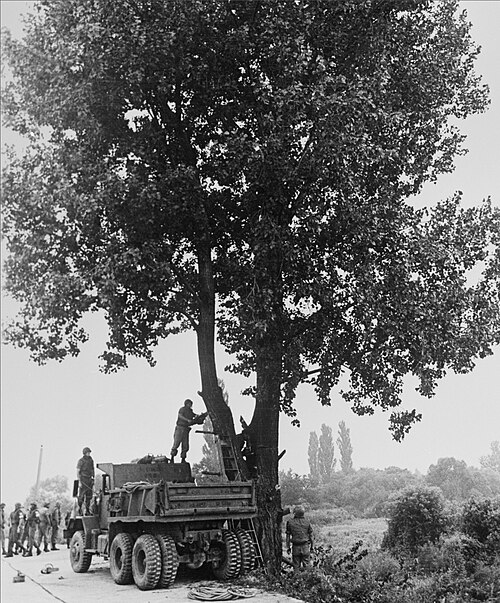
What was operation Paul Bunyan? Operation Paul Bunyan was an operation by American forces in 1976 to cut down a poplar tree in the Korean Demilitarized Zone in retaliation for the killing of two United Nations Command officers by North Korean soldiers.
The operation was named after Paul Bunyan who was an American legend. He was supposed to be a giant of a lumberjack who was so big that he created the Grand Canyon with his axe. The legend was most likely based on the lives of two real lumberjacks. One was a French-Canadian lumberjack called Fabian Fournier. He was taller than most men, but not big enough to create a canyon. This story merged with another French-Canadian lumberjack called Bon Jean, who had been involved in a rebellion in 1837. It is interesting that two French-Canadians became an American legend.
The operation in 1976 was called the Paul Bunyan Operation because of the legend of the lumberjack. The goal was to cut down a tree, but we need to look at some of the background first. The Korean War had been fought between 1950 and 1953. After the end of the war, a demilitarized zone (the DMZ) had been set up between the two countries to keep the armies apart. It didn’t just keep North Korea and South Korea apart, but was a buffer zone between the American army stationed in South Korea and the army of the USSR stationed in North Korea. The two groups of forces opposed each other, but there was no war. At least, there was no actual war. The North Koreans constantly tried to provoke the American and South Korean forces and used propaganda to say that the Americans were getting ready to attack. They blamed the Americans for threatening the peace and the amount of propaganda slowly increased through 1976. There is some thought that the North Koreans were using the propaganda to try and influence the 1976 American presidential elections. Tensions were rising.
Operation Paul Bunyan came about because of a simple attempt to prune a tree. There were observation towers on both sides of the DMZ. The view from one of the South Korean towers was obstructed by a tall poplar tree. The tree was about 30 m tall and it blocked out the tower’s view of a United Nations Command checkpoint. On August 18th, 1976, the simple decision was made to go into the DMZ and prune the tree back so it didn’t obstruct the tower’s view. A team of 5 South Korean soldiers and several members of the United Nations Command headed into the DMZ. They started to prune the tree and a contingent of 15 North Korean soldiers came out to watch them. The leader of the North Koreans, Lieutenant Pak Cheol ordered them to stop pruning. When they refused, he called for reinforcements. In the end, 35 North Korean soldiers assembled. The Americans and South Koreans were ordered to stop again and when they refused, Lieutenant Pak Cheol told his men to kill them. 2 of the Americans were clubbed to death, and several others were injured. 1 American actually fell off a wall into a ditch and the North Korean soldiers went down there to kill him with an axe. This is why it became known as the Korean axe murder incident. As is usual in these situations, the North Korean side very quickly issued a statement saying that they were the victims and had to defend themselves. They said that the Americans attacked 4 of their soldiers and they had no choice but to respond. The North Koreans even presented it at an international conference as an unprovoked attack by the Americans.
So, what was the Paul Bunyan Operation? The Americans had several choices of how to deal with this situation. They could not respond, but that would show weakness. They could try diplomacy, but again, that would be taken as weakness. Or, they could use an overwhelming amount of force to show their strength. They went with that option, and that became known as the Paul Bunyan Operation.
On August 21st, 23 American and South Korean vehicles drove into the DMZ with no warning and surrounded the tree. Two armed 30 man platoons followed them and secured the area. Then the show of force came. Altogether, 813 soldiers were sent in to the area. 27 armed helicopters flew overhead, and there was a flyover of B-52 Stratofortresses and F-4 Phantom fighter jets. An aircraft carrier stationed in Japan was also rerouted to the area. With the poplar tree surrounded, army engineers with chainsaws cut it down and then into pieces. The tree was carried away. The show of force appeared to have the desired effect. The incident didn’t escalate any further. And this is what I learned today.
Sources
https://en.wikipedia.org/wiki/Korean_axe_murder_incident
https://ns.clementspapers.org/briefing-books/korea-tree-incident
https://www.history.com/articles/was-paul-bunyan-a-real-person
Image By 대한민국 정부 – http://ehistory.korea.kr/page/pop/photo_pop.jsp?photo_PhotoSrcGBN=BK&photo_PhotoID=18&detl_PhotoDTL=3367, Public Domain, https://commons.wikimedia.org/w/index.php?curid=27460232
